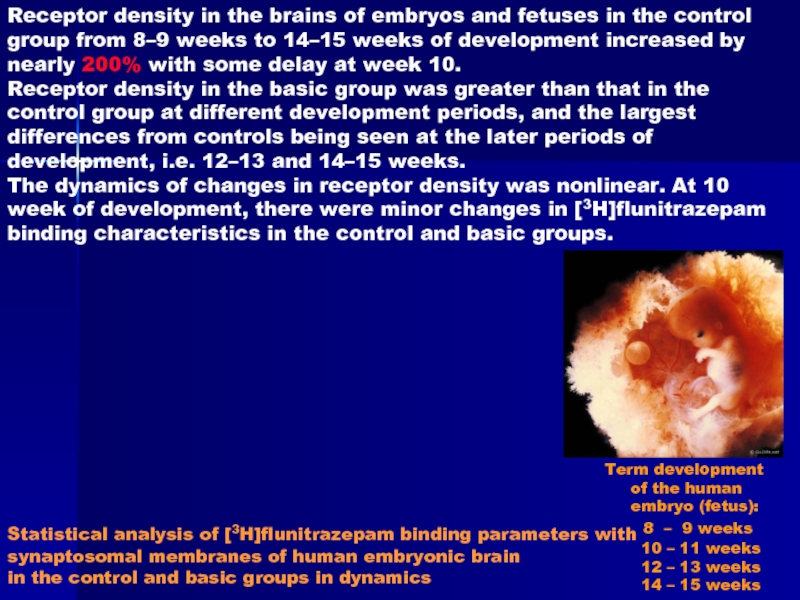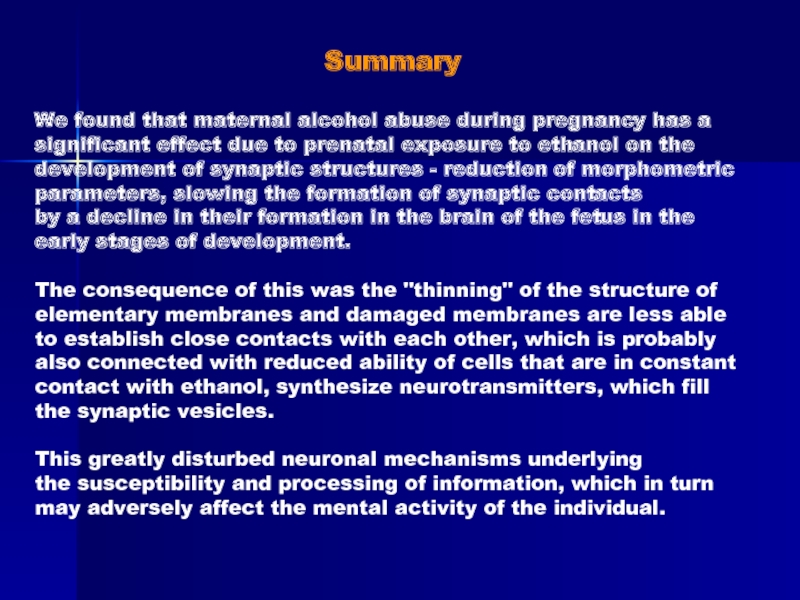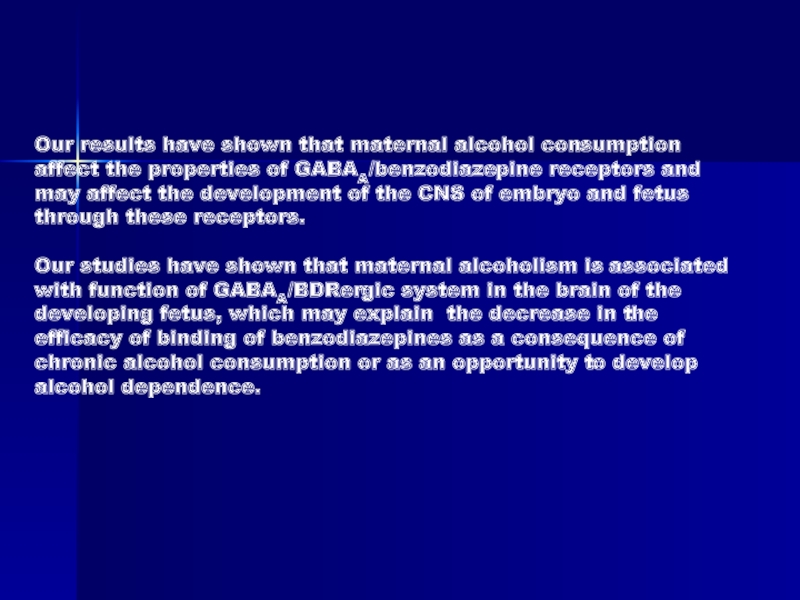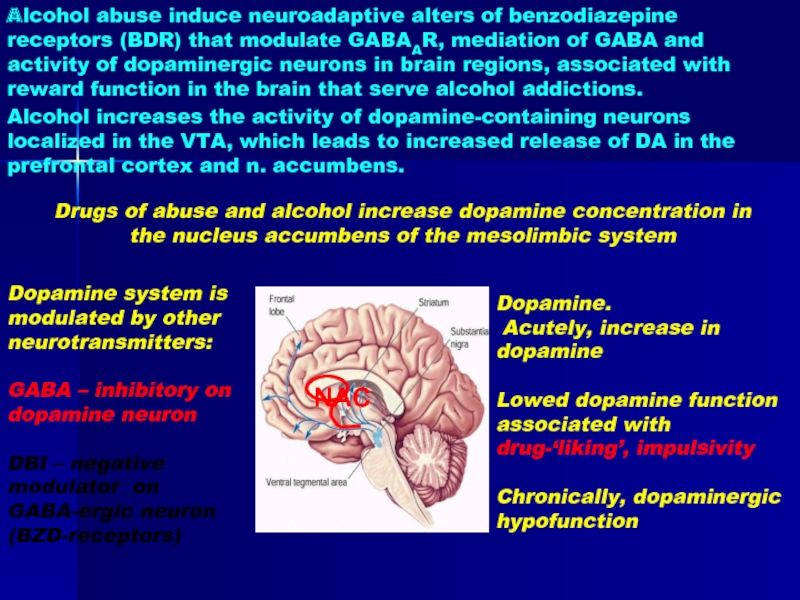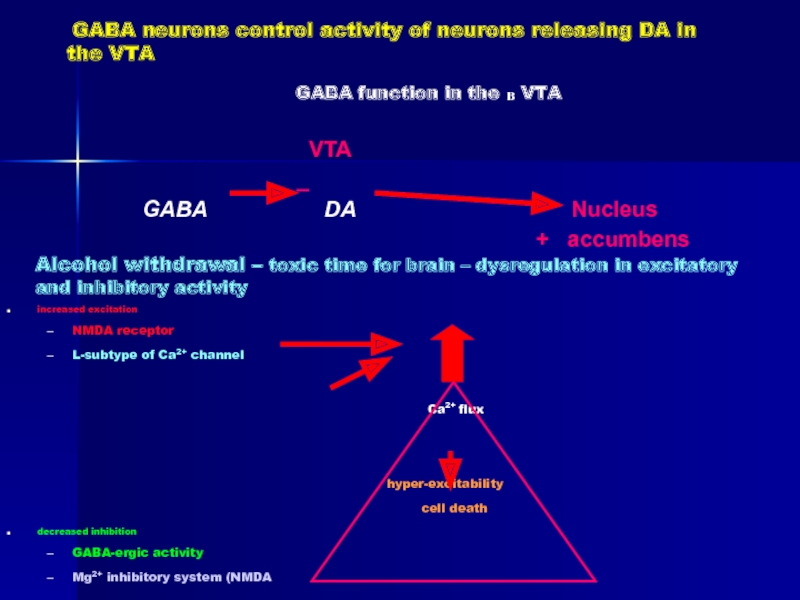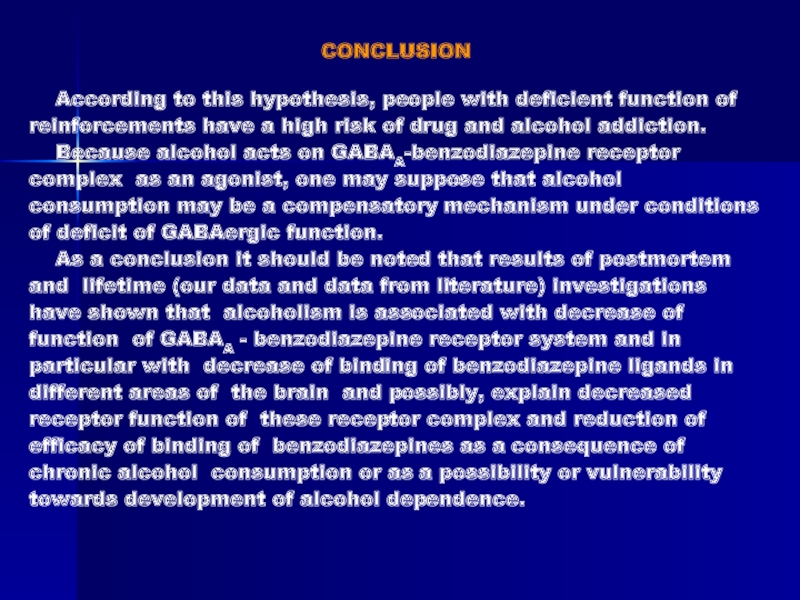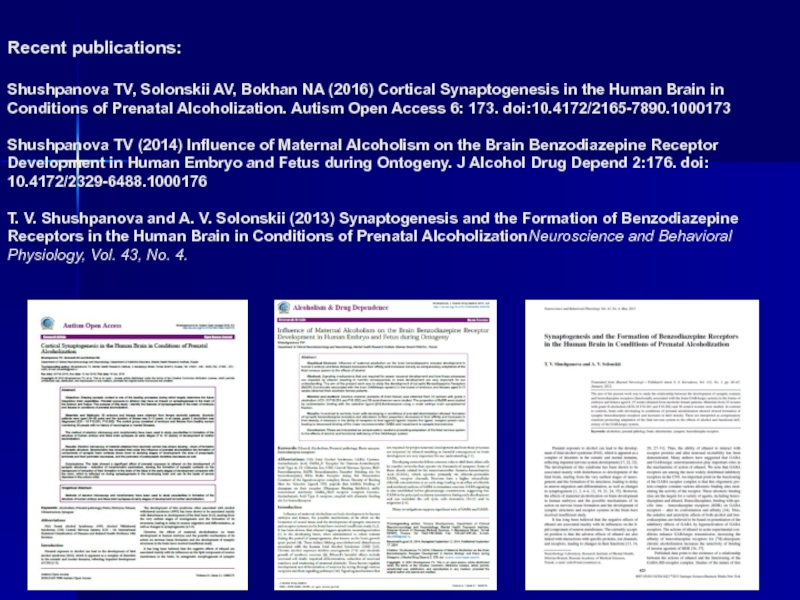Слайд 1 Russian conference with
international participation
“Biomarkers in psychiatry: identification and future direction”
Tomsk, Russia
12 – 13 May, 2016
Synaptogenesis and the formation
of benzodiazepine receptor system during human brain development
in condition of prenatal
alcoholization
Tamara V. Shushpanova
Anatoly V. Solonsky
Mental Health Research Institute
BACKGROUND
Prenatal exposure to alcohol can lead to the development of fetal alcohol syndrome (FAS), which is apparent as a complex of disorders in the somatic and mental domains, reflecting impaired nervous system development.
Damaging action of ethanol is the most expressed component of FAS, but mechanism underlying these effects remains insufficiently determined. Ethanol exerts wide variability of behavioral and physiological effects in the organism, but how it really acts is still unknown.
The development of this syndrome has been shown to be associated mainly with disturbances to development of the fetal brain, starting from the very earliest stages of neurogenesis and the formation of its structures, leading to delay in neuron migration and differentiation, as well as changes in synaptogenesis.
It has been established that ethanol triggers widely pervasive neurodegenerative process of apoptosis in developing brain in its consumption during period of synaptogenesis, also known as a period of brain growth.
In investigation of mechanisms of brain dysontogeny in offspring of mothers consuming alcohol in period of pregnancy, major role is played by neuromorphological and neurochemical investigations.
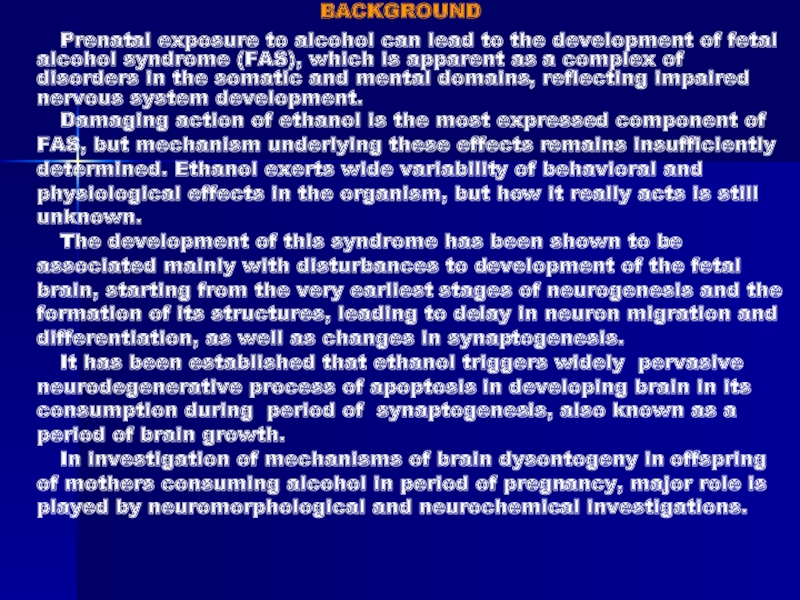
BACKGROUND
It has been long considered that ethanol acts non-specifically through disruptions of lipids of cellular membranes, the currently accepted position is that the adverse effects of ethanol are also linked with interactions with specific proteins, ion channels and receptors, leading to changes in their functions.
Many investigations suppose significant role of GABA and GABA -ergic neurotransmission in mechanisms of ethanol’s action.
Many neurotransmitters including GABA are candidates of growth factor in central nervous system (CNS).
GABA is widely known in current literature as neurotrophic agent being one of the key mediators necessary for neuronal development, and participating in development of human and animal brain. Most papers revealed interrelationship of effects of GABA and neuronal development in embryos and embryonic tissue culture during formation of neuronal tube in experiments, though GABA receptors are revealed at first.
GABA may play greater role what is regarded in development and formation of CNS in animals and humans. These receptor complex, which integral part is chloride channel, takes immediately part in development of the embryonic brain.
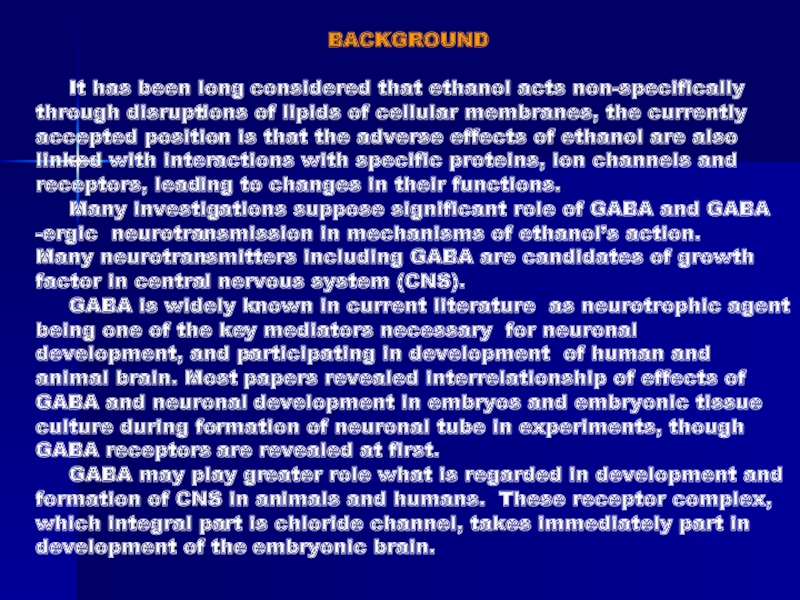
Слайд 4
It is now generally accepted that ethanol interacts with and
modifies the function of a number of membrane-bound proteins.
GABAA
receptors play central role in both the short- and long-term effects of ethanol in the CNS.
GABAARs belong to a family of trans - membrane ligand-gated ion channels.
These receptors are responsible for rapid neuronal transmission in the mammalian CNS. GABAARs primarily occur in the postsynaptic membrane, although there is evidence that certain subtypes may occur extra-synaptically.
GABAAR are the site of action of a number of drugs, including barbiturates, benzodiazepines and anesthetics.
The GABAAR are pentameric receptors having 5 subunits including various isoform of subunits: 6α, 4β, 3γ, 2ρ, δ, ε, θ and π. They have a rich pharmacology, and this is dependent upon the particular subunits that are present within the receptor pentamer.
GABA and benzodiazepine (BZD) allosteric binding sites are noted (between the α- and β-subunits interface and between the α- and γ-subunits). These receptor complex are integral part of chloride (Cl-) ion channel pore.
Image of function synaptic and exrasynaptic GABA receptor
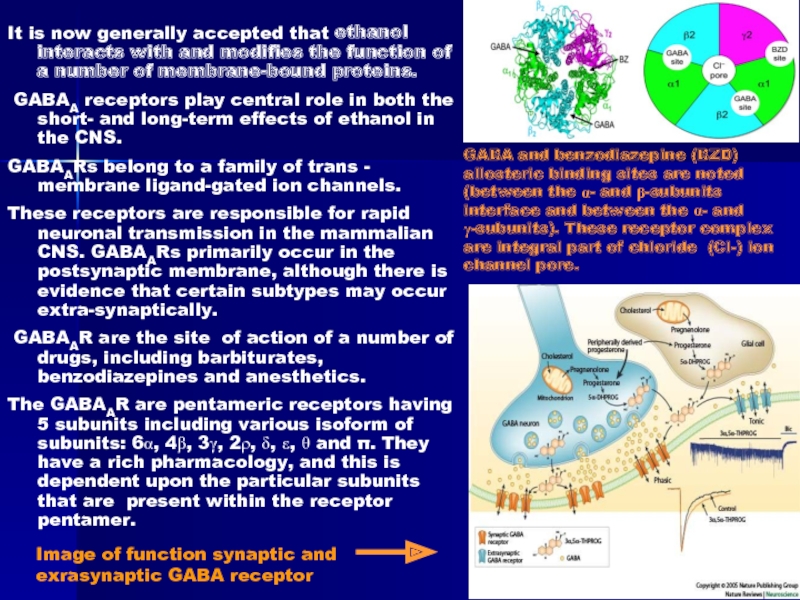
Слайд 5Each of the subunits of the receptor has an extracellular
domain that serves as a ligand binding site, and four
transmembrane domains which are involved in the creation of a chloride ion channel structure
Diagrammatic representation GABAAR (A) Top view of GABA and BZD binding sites. (B) Side view.
Berezhnoy et al. (2007).
Слайд 6Model action of ethanol and other anesthetic efficacy in enhancing
GABA
Synaptic receptors (mainly prevail 122 synaptic GABA receptors) respond
to saturating concentration of GABA (≥ 1mM GABA).
Extrasynaptic receptors (consisting of 4- or 6- and 3- common subunits) activated low-saturating concentrations of GABA (0.5–1 M) and sensitive to low concentrations of neurosteroids and ethanol. Neurosteroids positively modulate GABAARs.
M. Wallner*, H. J. Hanchar*, and R. W. Olsen† PNAS, 2003.
Слайд 7BACKGROUND
Substances acting on GABAA receptors (ethanol, benzodiazepines, and barbiturates) are
able to influence adversely on development of CNS. Benzodiazepine and
alcohol, reinforcing activity of GABAA -receptors also increase teratogenic effects in animals and humans and give rise to defects of formation of neuronal tube.
Because processes of brain development have close association with functioning of GABAA/BDRergic system, it is important to investigate the influence of GABA-active substances including ethanol on development of CNS.
Our investigations continue study of influence of alcohol on the
benzodiazepine receptors and in particular receptors of developing human brain.
OBJECTIVE
The aim of this investigation was to study the dynamics of formation and development of synaptic contacts and benzodiazepine receptors of brain synapses of embryos and fetuses aged 8-15 weeks of development, obtained from healthy women and alcoholic female patients.
Materials and Methods
The brains of human embryos and fetuses at 8–15 weeks of development were studied, obtained in compliance with the requirements of the Ethics Committee and with patients’ consent during pregnancy termination procedures for medical indications. A total of 33 embryos and fetuses were obtained from female alcoholic patients and constituted the basic group.
Alcoholic patients were aged 26–39 years and the duration of illness was 3–13 years. In all cases alcoholism was diagnosed (ICD-10 F10.201, F10.202). Diagnoses of alcoholism were established at the Department of Addictive States of Mental Health Institute, Siberian Branch, Russian Academy of Medical Sciences. The control group consisted of embryos and fetuses (n=30) obtained from healthy women with no history of neurological or mental illnesses.
Electronic-microscopic and morphometric investigations of tissue of embryonic brains were used. BDR were studied by radioreceptor binding with the selective ligand [3H]flunitrazepam using a crude embryo brain synaptosomal fraction. Radioanalysis of the quantity of bound ligand was performed in a Rack-beta scintillation β counter. The dissociation constant (Kd) and maximum number of specific binding sites (Bmax) were determined by analysis of saturation curves in Scatchard coordinates.
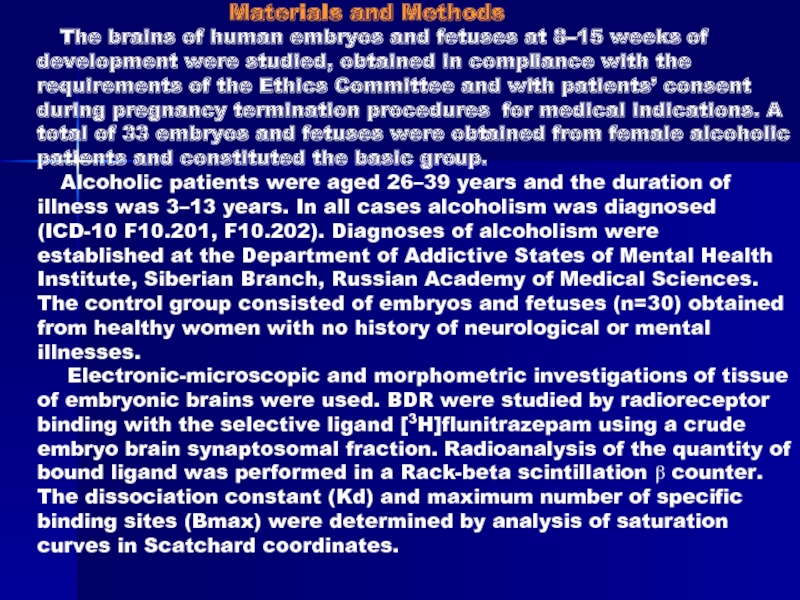
Слайд 9TASKS OF RESEARCH
To study neuro-morphological peculiarities of developing synapses of
embryonic brain in norm and in alcoholization of mother 8-12
weeks of prenatal development.
To carry out computer-morphometric investigation of embryonic synapses of brain of 8-12 weeks of prenatal development, assess influence of alcohol on state, peculiarities of synaptic parameteres (perimeter pre-synaptic terminals, area of pre-synaptic terminals, length postsynaptic indurations).
To study characteristics of the binding of [3H]flunitrazepam with synaptosomal benzodiazepine receptors of human embryonic brain in norm and in alcoholization of mothers 8-15 weeks of prenatal development.
Слайд 10METHODS
Electronic-microscopic and morphometric investigations of tissue of embryonic brains
Computer morphometry
of digital micro-photos with Scion Image program
Radioactive analysis of amount
of bound ligand [3H]flunitrazepam, radioreceptor assay
Statistic processing.
Слайд 11Intercellular contacts
In embryonic human in early period of
development, starting with the 8th week, desmosome-like contacts are prevalent.
Contacting membranes are in their middle part of this thickening, which both sides approach to each other, forming a fissure.
In places of the thickening the membrane can be connected. This electron-dense material is most substantial in the field of adhesion. Contacts of this type are found between bodies of cells and different dendrites.
In later terms of the development (weeks 8-10) indicated types of the contacts are found more seldom. Junctions with presence of vesicular elements have been distinguished. Synaptic vesicles usually had a rounded shape and bright center and their diameter was about 40 nm. The fissure width of immature synapses was about 20 nm. The length of the sealing membrane area reached 0,1-0,15 mk.
Contact with evenly thickened membranes.
Basic group, fetus 10-11 weeks, magnified 160 000.
Ultrastructure of contacts
The emergence of single synaptic vesicles near the presynaptic membrane is believed the transitional stage from synapsis-like contacts to their true synaptic form. In general, these synapses could be called functionally competent. They are located predominantly in the lower boundary of the intermediary layer of the cerebral cortex.
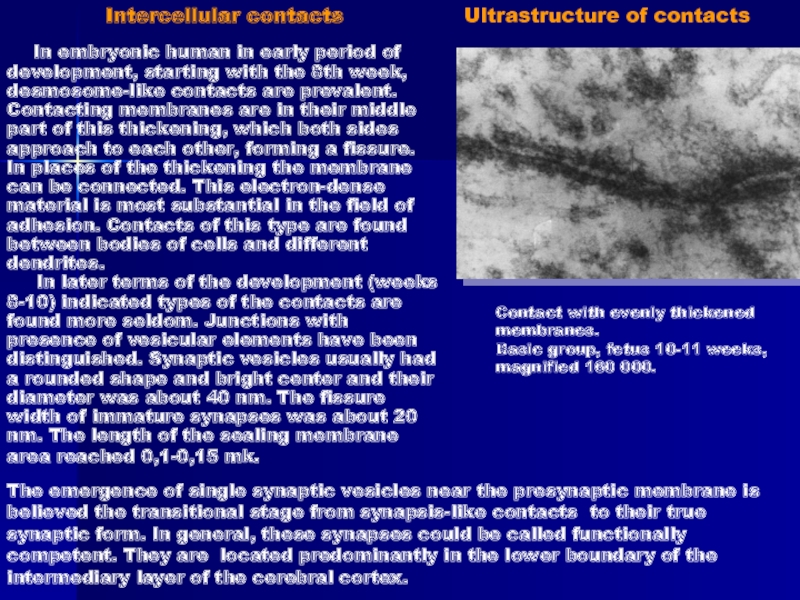
Слайд 12Intercellular contacts
At the stage of 10-12 weeks the number of
synapses with relatively mature structures increases. More likely they could
be found at the boundary of ventricular and intermediary layers, and in the intermediary layer of nerve cells and the cortical plate. Synaptic contacts have all the necessary components, differing from the mature brain synapses, fewer synaptic vesicles. Synaptic contacts on neuroblasts and glioblasts differed from synapses of the mature brain with smaller number of synaptic vesicles. All the above features were characterized as the control and basic groups of embryos.
On inputs received from women-alcoholics, found slowing the formation of synaptic structures. It forms of non-synaptic compounds in frequency and structure did not differ from the controls. Fully formed structure of synaptic connections in the appearance of synaptic vesicles are compared with the control, but the area of core synapse was less.
Functionally competent synapse. Control group, fetus 11 weeks, magnified 60 000
Completely formed functionally
competent synapse. Basic group,
fetus 11 weeks, magnified 70 000
Ultrastructure of synapses
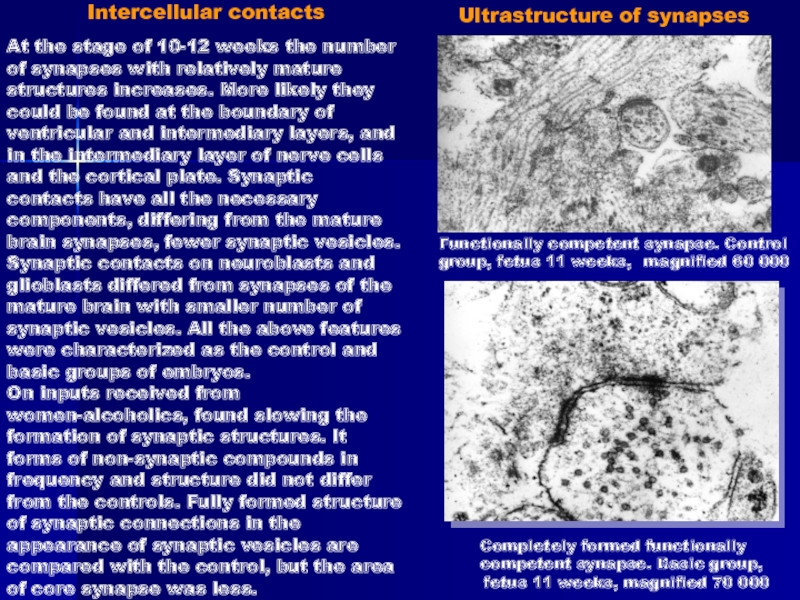
Слайд 13Ultrastructure of synapses
Single synaptic vesicles in the area of forming
contact. Basic group, fetus 12 weeks.
Above – magnified 60
000,
Under – magnified 144 000
In cells of brain of embryos from basic group (from women with alcoholism) slowing down of formation of synaptic structures as compared with the norm may be the cause of an alteration of neuromediator transmission.
Слайд 14Morphometric analysis
Photos taken from negatives of
format 6x9 cm obtained with use of electronic microscope were
exposed to morphometric analysis. Images were scanned in gradations of grey with resolution 300 dpi, with retention in format TIFF without compression. Some negatives were digitized with scanner. On photos we investigated area of presynaptic terminal, its perimeter as well as length of postsynaptic thickening with the help of program Scion Image for Windows, developed at National Institute of Health by firm Scion Corporation.
We took for analysis 5 cases from each age period in control and basic groups. From each case we used 15-20 microphotos from different areas of intermediary layer. Results of measurements are represented in relative values, expressing number of pixels (p) during assessment of length, and number of pixels of image squared (p2) during assessment of area of structural components of synapses for study of dynamic characteristics.
Distribution of signs did not reliably differ from normal, this is why for statistical processing of data we used parametric method of variation statistics (Student’s criterion) with program Statistica 6.0, differences were significant at P<0,05.
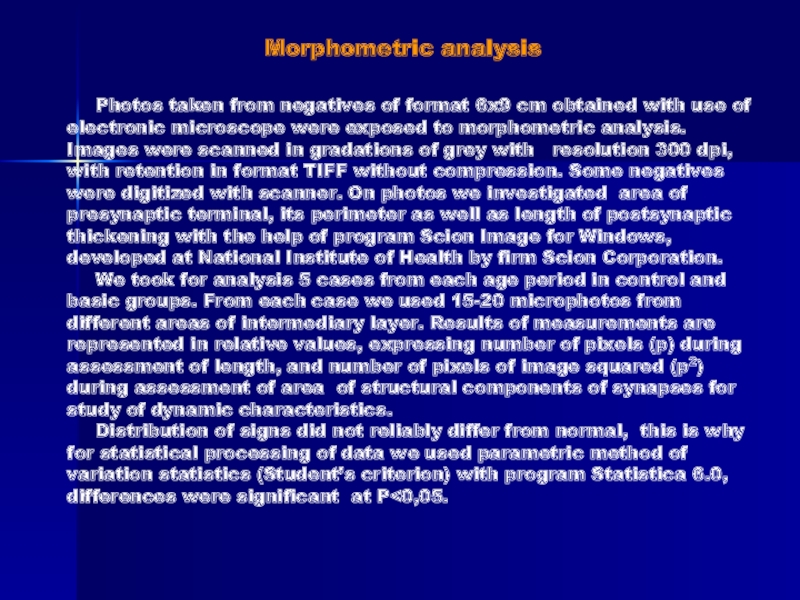
Слайд 15Computer morphometry of
synaptic brain contacts
Morphometry was administered to synapses
of cells of intermediary layer of the wall of the
brain's frontal lobe.
Quantitative assessments by computerized morphometric analysis were performed by subdividing electron micrographs of embryo brain synapses into four groups, according to the period of embryo development: 7-8, 9-10, 10-11, and 11-12 weeks. This was performed in both the study group and the control group.
For every studied parameter of synapses (perimeter of pre-synaptic terminal, area of pre-synaptic In duration and length of postsynaptic in duration) we have analyzed from 300 to 500 values of signs per every term of development in control and basic groups of investigation.
Слайд 16RESULTS: Statistical analysis of morphometric indices (perimeters, area, length) of
presynaptic terminals in control and basic groups according to weeks
of development
Quantitative morphometric parameters of synaptic connections of development human brain in the basic and control group differ significantly, with the basic group rates slightly lower. According to our data, alcohol has a modifying influence on the formation of intercellular relationships.
Слайд 17RADIORECEPTOR ASSAY
Properties of BDR were investigated by radioreceptor method
of binding selective ligands [3H]flunitrazepam ("Amersham") with crude synaptosomal fraction
of embryonic brain tissue in final concentration 0.2-10 nM. Final protein concentration in incubation medium has constituted 0.3 mg/ml. Non-specific binding was revealed in presence of non-radioactive ligand in concentration 10 mcM. Radioactive analysis of amount of bound ligand was carried out in scintillated β-counter "Rack-beta" ("LKB"). Constant of dissociation (Kd) and maximum number sites of specific binding (B max.) were revealed with method of analysis of curves of saturation in Sketchard coordinates.
Statistical processing of the material was carried out with use of criterion of Student’s t-criterion.
Слайд 18
Properties of the [3H]flunitrazepam binding with synaptosomal membranes
from human
embryonic brains (8–15 weeks of development)
Study the kinetic characteristics of
[3Н]flunitrazepam binding (Kd – dissociation constant of the receptor complex and Bmax – maximum number of specific binding sites) to synaptosomal membranes prepared from brain tissue of human embryos and fetuses showed that absolute value of these parameters were increased during ontogeny in control and basic groups.
These data support the general pattern consisting of an increase in receptor number in human brain during ontogeny. BDR affinity (inverse of the receptor dissociation constant - 1/Kd) also changed, reflecting a tendency to decrease with increasing developmental period, which was reflected in increasing values of Kd.
Differences are reliable, p<0.02
Слайд 19
Statistical analysis of [3H]flunitrazepam binding parameters with synaptosomal membranes of
human embryonic brain in the control and basic groups in
dynamics
Term development
of the human
embryo (fetus):
8 – 9 weeks
10 – 11 weeks
12 – 13 weeks
14 – 15 weeks
In the control group receptor affinity in the brains of embryos and fetuses during development from 8–9 to 14–15 weeks decreased, i.e., Kd increased from 1.5 to 2.12 nM.
In the basic group, BDR affinity in synaptosomal membranes isolated from the brains of human embryos and fetuses from alcoholic mothers was lower at all the developmental stages studied than in the control group, which was apparent as an increase in absolute Kd values from 8–9 to 14–15 weeks, i.e., from 1.59 to 2.45 nM.
The dynamics of changes in receptor affinity was nonlinear. There was some slowing in the increase Kd in the basic group.
Слайд 20 Term development
of the human
embryo (fetus):
8 – 9 weeks
10 – 11 weeks
12 – 13 weeks
14 – 15 weeks
Statistical analysis of [3H]flunitrazepam binding parameters with synaptosomal membranes of human embryonic brain
in the control and basic groups in dynamics
Receptor density in the brains of embryos and fetuses in the control group from 8–9 weeks to 14–15 weeks of development increased by nearly 200% with some delay at week 10.
Receptor density in the basic group was greater than that in the control group at different development periods, and the largest differences from controls being seen at the later periods of development, i.e. 12–13 and 14–15 weeks.
The dynamics of changes in receptor density was nonlinear. At 10 week of development, there were minor changes in [3H]flunitrazepam binding characteristics in the control and basic groups.
Слайд 21
A decrease in the
ability of receptors to bind agonist ligands impairs the ligand:
receptor protein ratio, leading to decreased binding of the major neurotransmitter GABA and impairment to synaptic transmission.
The action of alcohol may lead to changes in BDR conformation, with increases in affinity for the major agonist. In addition, endogenous DBI peptide (Diazepam Binding Inhibitor) has been shown to have anxiogenic actions, i.e., to be an inverse agonist of BDR.
Alcohol may stimulate the synthesis of an endogenous polypeptide DBI interacting with BDR and decreasing their binding affinity with the GABAAR agonist [3H]flunitrazepam.
The tendency to an increase in receptor density can be evaluated as a compensatory reaction directed to adapting the embryo and fetus nervous system to conditions of functional insufficiency of GABAergic neurotransmission.
The results obtained here support the view that maternal alcohol consumption, which influences the processes of synaptosomal BDR formation to modulate GABA receptor function, impairs the development of the embryo and fetus brain and can lead to various somatic and mental disorders, including the development of fetal alcohol syndrome.
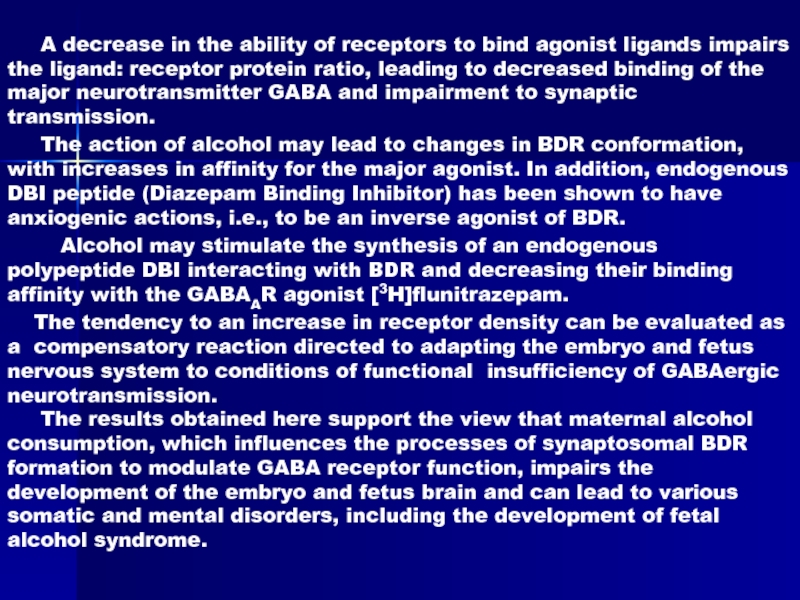
Слайд 22Summary
We found that maternal alcohol abuse during pregnancy has
a significant effect due to prenatal exposure to ethanol on
the development of synaptic structures - reduction of morphometric parameters, slowing the formation of synaptic contacts
by a decline in their formation in the brain of the fetus in the early stages of development.
The consequence of this was the "thinning" of the structure of elementary membranes and damaged membranes are less able to establish close contacts with each other, which is probably
also connected with reduced ability of cells that are in constant contact with ethanol, synthesize neurotransmitters, which fill the synaptic vesicles.
This greatly disturbed neuronal mechanisms underlying
the susceptibility and processing of information, which in turn may adversely affect the mental activity of the individual.
Слайд 23
Our results have shown that maternal alcohol consumption affect the
properties of GABAA/benzodiazepine receptors and may affect the development of
the CNS of embryo and fetus through these receptors.
Our studies have shown that maternal alcoholism is associated with function of GABAA/BDRergic system in the brain of the developing fetus, which may explain the decrease in the efficacy of binding of benzodiazepines as a consequence of chronic alcohol consumption or as an opportunity to develop alcohol dependence.
Слайд 24
Adaptive changes of GABAA receptors (increased expression of isoforms of
subunits α6, α4, β3, δ and reduced α1, α2, β2)
are associated with decreased sensitivity to GABA and ethanol - the development of tolerance, decreased GABAergic function in the brain structures leads to increased anxiety and self-stimulation reinforcement processes in the brain, causing compulsive habits.
BDR "central type" allosterically modulate GABAergic function by regulating the processes of excitation and inhibition, affecting the DA activity in brain structures involved in the process of natural reinforcements. Higher affinity and density of receptors in the caudate nucleus and prefrontal cortex associated with their functional activity in regulating emotions and motivated behavior.
The activity of neurons that release dopamine in the VTA, normally controlled by neurons that produce GABA. Upon activation of GABA neurons, their signals reduce "kindling" DA-ergic neurons.
Alcohol increases the activity of dopamine-containing neurons localized in the VTA, which leads to increased release of DA in the prefrontal cortex and n. accumbens.
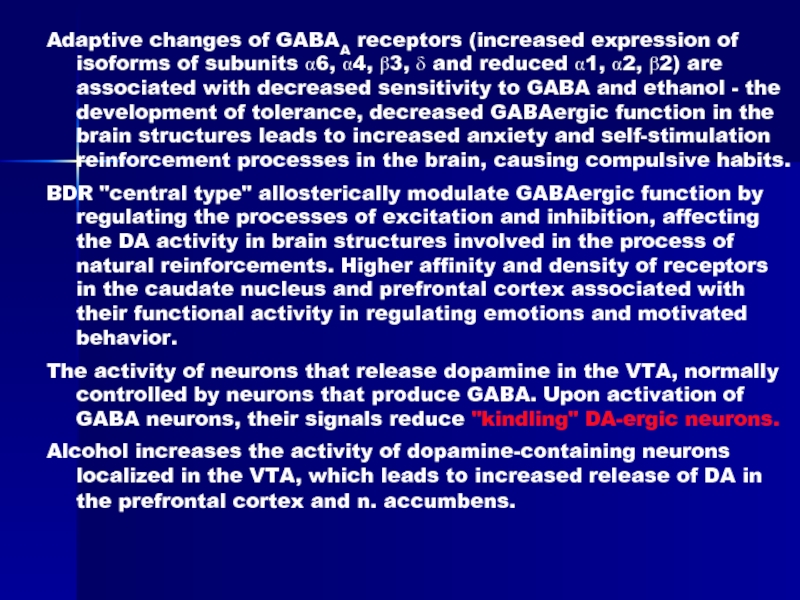
Слайд 25
Dopamine system is modulated by other neurotransmitters:
GABA – inhibitory
on dopamine neuron
DBI – negative modulator on GABA-ergic neuron (BZD-receptors)
Drugs
of abuse and alcohol increase dopamine concentration in the nucleus accumbens of the mesolimbic system
Alcohol abuse induce neuroadaptive alters of benzodiazepine receptors (BDR) that modulate GABAAR, mediation of GABA and activity of dopaminergic neurons in brain regions, associated with reward function in the brain that serve alcohol addictions.
Alcohol increases the activity of dopamine-containing neurons localized in the VTA, which leads to increased release of DA in the prefrontal cortex and n. accumbens.
Dopamine.
Acutely, increase in dopamine
Lowed dopamine function associated with drug-‘liking’, impulsivity
Chronically, dopaminergic hypofunction
Слайд 26 GABA neurons control activity of neurons releasing DA in
the VTA
increased excitation
NMDA receptor
L-subtype of Ca2+ channel
Ca2+ flux
hyper-excitability
cell death
decreased inhibition
GABA-ergic activity
Mg2+ inhibitory system (NMDA
Anne Lingford-Hughes, 2009
receptor)
Alcohol withdrawal – toxic time for brain – dysregulation in excitatory and inhibitory activity
GABA function in the в VTA
VTA
_
GABA DA Nucleus
+ accumbens
Слайд 27CONCLUSION
According to this hypothesis, people with deficient function
of reinforcements have a high risk of drug and alcohol
addiction.
Because alcohol acts on GABAA-benzodiazepine receptor complex as an agonist, one may suppose that alcohol consumption may be a compensatory mechanism under conditions of deficit of GABAergic function.
As a conclusion it should be noted that results of postmortem and lifetime (our data and data from literature) investigations have shown that alcoholism is associated with decrease of function of GABAA - benzodiazepine receptor system and in particular with decrease of binding of benzodiazepine ligands in different areas of the brain and possibly, explain decreased receptor function of these receptor complex and reduction of efficacy of binding of benzodiazepines as a consequence of chronic alcohol consumption or as a possibility or vulnerability towards development of alcohol dependence.
Слайд 28
Recent publications:
Shushpanova TV, Solonskii AV, Bokhan NA (2016) Cortical Synaptogenesis
in the Human Brain in Conditions of Prenatal Alcoholization. Autism
Open Access 6: 173. doi:10.4172/2165-7890.1000173
Shushpanova TV (2014) Influence of Maternal Alcoholism on the Brain Benzodiazepine Receptor Development in Human Embryo and Fetus during Ontogeny. J Alcohol Drug Depend 2:176. doi: 10.4172/2329-6488.1000176
T. V. Shushpanova and A. V. Solonskii (2013) Synaptogenesis and the Formation of Benzodiazepine Receptors in the Human Brain in Conditions of Prenatal AlcoholizationNeuroscience and Behavioral Physiology, Vol. 43, No. 4.
Слайд 29 We all bring joy to each
other
Thank you very much for your attention!
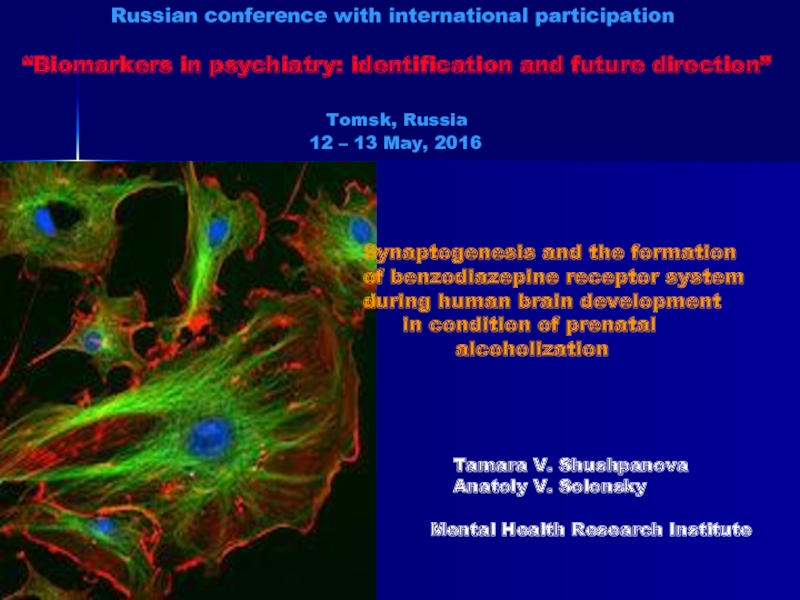



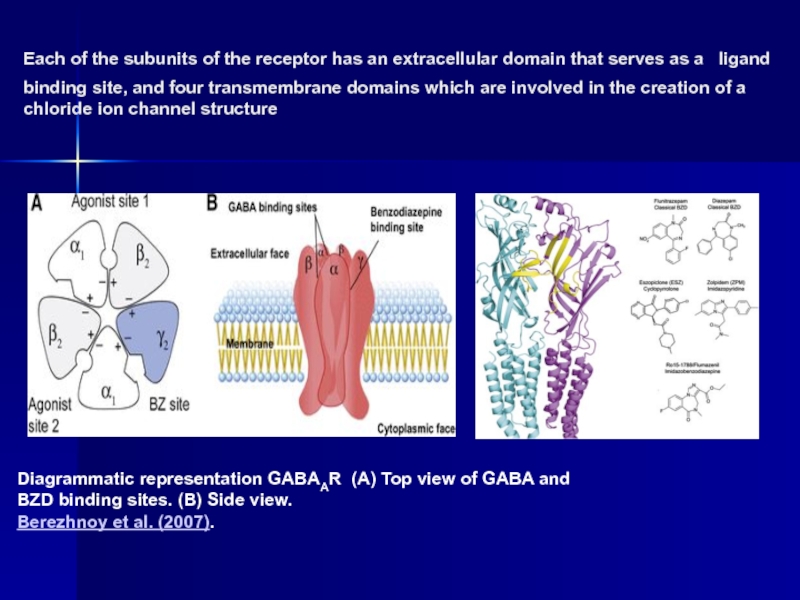
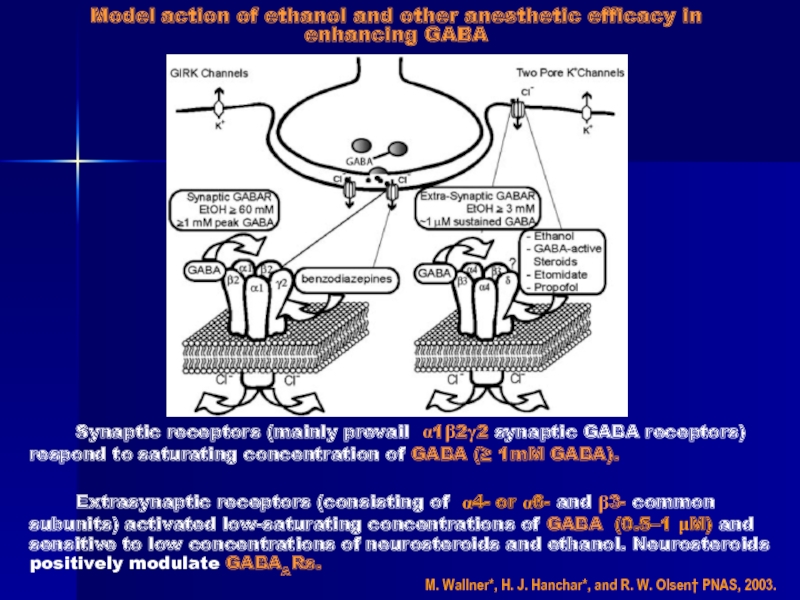
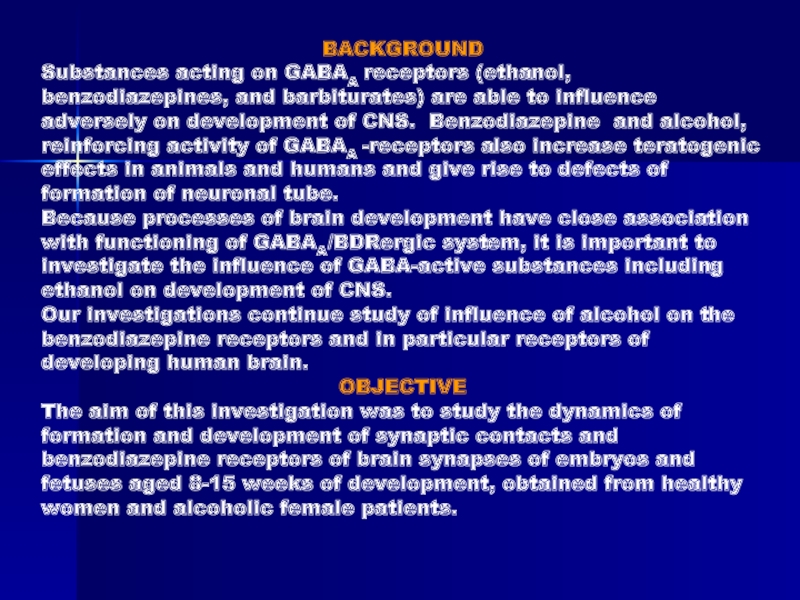

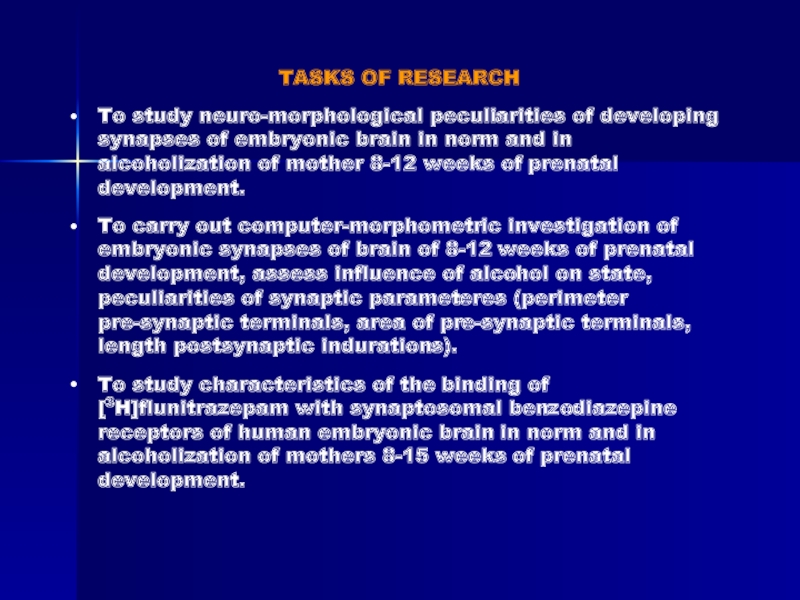
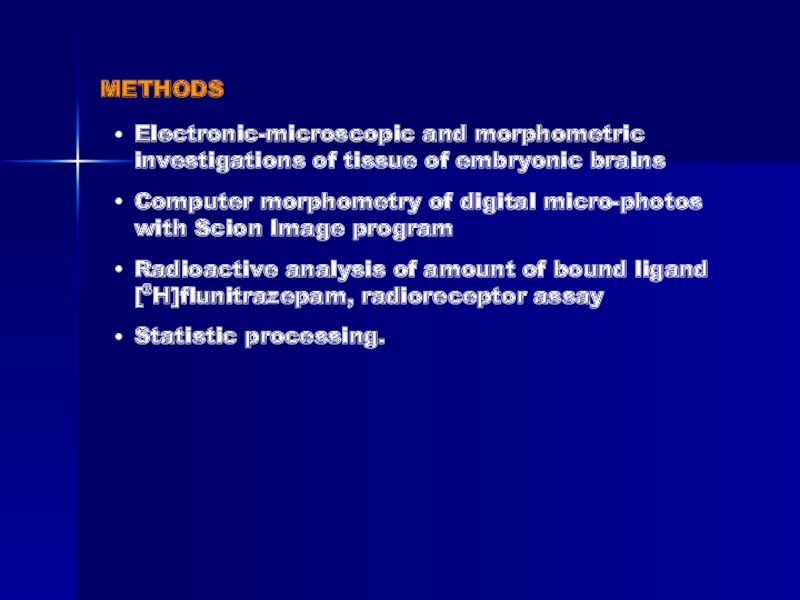


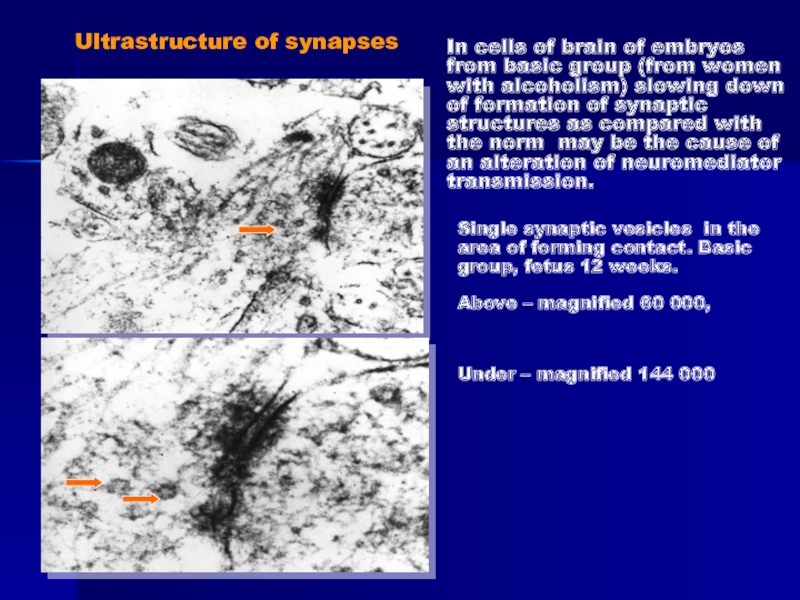

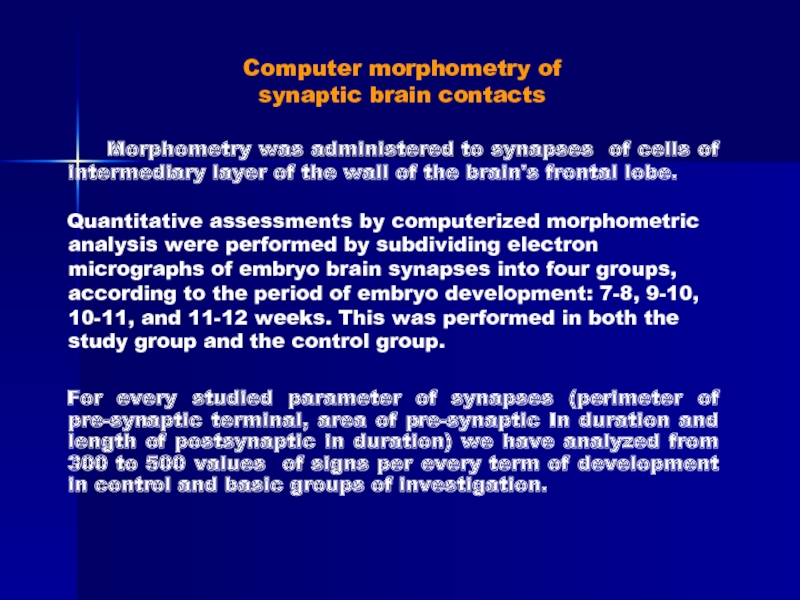
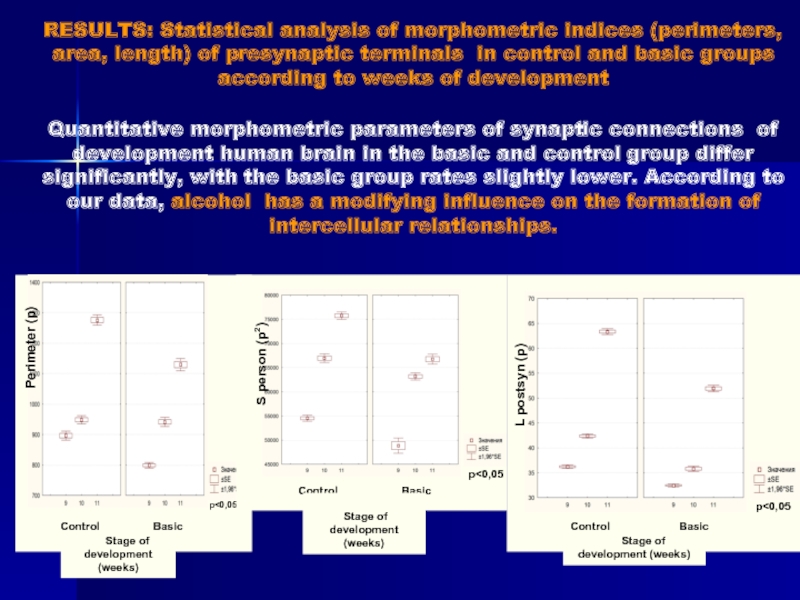
![Russian conference with international participation “Biomarkers in psychiatry: RADIORECEPTOR ASSAY Properties of BDR were investigated by radioreceptor method of RADIORECEPTOR ASSAY Properties of BDR were investigated by radioreceptor method of binding selective ligands [3H]flunitrazepam (](/img/thumbs/2ac81b59e66f244a5bc82f98756e6456-800x.jpg)
![Russian conference with international participation “Biomarkers in psychiatry: Properties of the [3H]flunitrazepam binding with synaptosomal membranes from human embryonic Properties of the [3H]flunitrazepam binding with synaptosomal membranes from human embryonic brains (8–15 weeks of development)Study the](/img/thumbs/18a132b7812b38498af7b5acadb33ca9-800x.jpg)
![Russian conference with international participation “Biomarkers in psychiatry: Statistical analysis of [3H]flunitrazepam binding parameters with synaptosomal Statistical analysis of [3H]flunitrazepam binding parameters with synaptosomal membranes of human embryonic](/img/thumbs/5f33a6b49c0036776da9118a47d49d19-800x.jpg)
